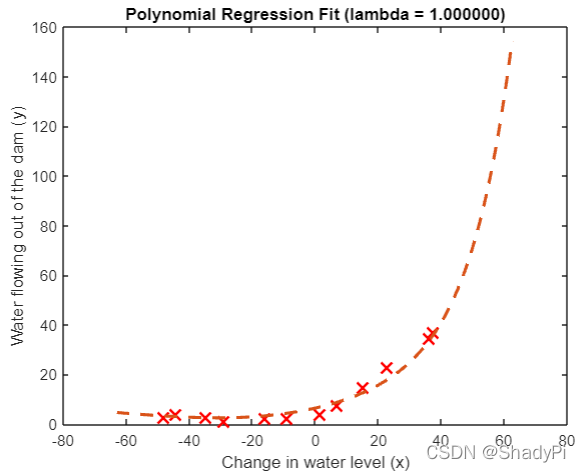
机器学习:使用matlab实现曲线线性回归拟合并绘制学习曲线
来自coursea机器学习课程ex5。使用线性回归拟合多项式曲线,并通过学习曲线评估模型加以改进
数据集划分
先将数据集划分为训练集、验证集和测试集,标记为X,y、Xval,yval和Xtest,ytest。关于数据集划分的内容可看这篇博客。
数据可视化
吴恩达作业常规第一步,数据可视化,这里只可视化了训练集:
% Load from ex5data1:
% You will have X, y, Xval, yval, Xtest, ytest in your environment
load ('ex5data1.mat');
% m = Number of examples
m = size(X, 1);
% Plot training data
figure;
plot(X, y, 'rx', 'MarkerSize', 10, 'LineWidth', 1.5);
xlabel('Change in water level (x)');
ylabel('Water flowing out of the dam (y)');

代价-梯度函数
线性回归算是最基础的机器学习算法了,它的代价和梯度的公式相信大🔥也不陌生,代价函数为
J
(
θ
)
=
1
2
m
∑
i
=
1
m
(
θ
0
x
0
(
i
)
+
θ
1
x
1
(
i
)
+
⋯
+
θ
n
x
n
(
i
)
−
y
(
i
)
)
2
+
λ
2
m
∑
j
=
1
n
θ
j
2
J(\theta)=\frac{1}{2m}\sum_{i=1}^m(\theta_0x_0^{(i)}+\theta_1x_1^{(i)}+\cdots+\theta_nx_n^{(i)}-y^{(i)})^2+\frac{\lambda}{2m}\sum_{j=1}^n\theta_j^2
J(θ)=2m1i=1∑m(θ0x0(i)+θ1x1(i)+⋯+θnxn(i)−y(i))2+2mλj=1∑nθj2
梯度为
∂
J
(
θ
)
∂
θ
j
=
1
m
∑
i
=
1
m
x
j
(
i
)
(
θ
0
x
0
(
i
)
+
θ
1
x
1
(
i
)
+
⋯
+
θ
n
x
n
(
i
)
−
y
(
i
)
)
+
λ
m
θ
j
\frac{\partial J(\theta)}{\partial \theta_j}=\frac{1}{m}\sum_{i=1}^m x_j^{(i)}(\theta_0x_0^{(i)}+\theta_1x_1^{(i)}+\cdots+\theta_nx_n^{(i)}-y^{(i)})+\frac{\lambda}{m}\theta_j
∂θj∂J(θ)=m1i=1∑mxj(i)(θ0x0(i)+θ1x1(i)+⋯+θnxn(i)−y(i))+mλθj
向量化过程也蛮简单的,注意一下
θ
0
\theta_0
θ0不参与正则化就好,我就直接上代码了:
function [J, grad] = linearRegCostFunction(X, y, theta, lambda)
%LINEARREGCOSTFUNCTION Compute cost and gradient for regularized linear
%regression with multiple variables
% [J, grad] = LINEARREGCOSTFUNCTION(X, y, theta, lambda) computes the
% cost of using theta as the parameter for linear regression to fit the
% data points in X and y. Returns the cost in J and the gradient in grad
% Initialize some useful values
m = length(y); % number of training examples
% You need to return the following variables correctly
J = 0;
grad = zeros(size(theta));
% ====================== YOUR CODE HERE ======================
% Instructions: Compute the cost and gradient of regularized linear
% regression for a particular choice of theta.
%
% You should set J to the cost and grad to the gradient.
%
h=X*theta;
J=sum((h-y).^2)/(2*m);
J=J+(lambda/(2*m))*(sum(theta.^2)-theta(1)^2);
grad=X'*(h-y)/m;
tmp=grad(1);
grad=grad+(lambda/m)*theta;
grad(1)=tmp;
% =========================================================================
grad = grad(:);
end
求解
求解过程很简单,调用我们写的代价-梯度函数即可,吴恩达直接提供了代码:
function [theta] = trainLinearReg(X, y, lambda)
%TRAINLINEARREG Trains linear regression given a dataset (X, y) and a
%regularization parameter lambda
% [theta] = TRAINLINEARREG (X, y, lambda) trains linear regression using
% the dataset (X, y) and regularization parameter lambda. Returns the
% trained parameters theta.
%
% Initialize Theta
initial_theta = zeros(size(X, 2), 1);
% Create "short hand" for the cost function to be minimized
costFunction = @(t) linearRegCostFunction(X, y, t, lambda);
% Now, costFunction is a function that takes in only one argument
options = optimset('MaxIter', 200, 'GradObj', 'on');
% Minimize using fmincg
theta = fmincg(costFunction, initial_theta, options);
end
线性拟合
首先我们尝试用一根直线(一个特征值两个参数)去拟合,肯定效果不咋地,这是结果:

绘制学习曲线
显然上面出现的是欠拟合问题,我们可以通过它的学习曲线来确认这一判断。计算训练代价和验证代价的函数与代价函数基本相同,但不包含正则项。然后边改变训练集大小边计算代价即可:
function [error_train, error_val] = ...
learningCurve(X, y, Xval, yval, lambda)
%LEARNINGCURVE Generates the train and cross validation set errors needed
%to plot a learning curve
% [error_train, error_val] = ...
% LEARNINGCURVE(X, y, Xval, yval, lambda) returns the train and
% cross validation set errors for a learning curve. In particular,
% it returns two vectors of the same length - error_train and
% error_val. Then, error_train(i) contains the training error for
% i examples (and similarly for error_val(i)).
%
% In this function, you will compute the train and test errors for
% dataset sizes from 1 up to m. In practice, when working with larger
% datasets, you might want to do this in larger intervals.
%
% Number of training examples
m = size(X, 1);
% You need to return these values correctly
error_train = zeros(m, 1);
error_val = zeros(m, 1);
% ====================== YOUR CODE HERE ======================
% Instructions: Fill in this function to return training errors in
% error_train and the cross validation errors in error_val.
% i.e., error_train(i) and
% error_val(i) should give you the errors
% obtained after training on i examples.
%
% Note: You should evaluate the training error on the first i training
% examples (i.e., X(1:i, :) and y(1:i)).
%
% For the cross-validation error, you should instead evaluate on
% the _entire_ cross validation set (Xval and yval).
%
% Note: If you are using your cost function (linearRegCostFunction)
% to compute the training and cross validation error, you should
% call the function with the lambda argument set to 0.
% Do note that you will still need to use lambda when running
% the training to obtain the theta parameters.
%
% Hint: You can loop over the examples with the following:
%
% for i = 1:m
% % Compute train/cross validation errors using training examples
% % X(1:i, :) and y(1:i), storing the result in
% % error_train(i) and error_val(i)
% ....
%
% end
%
% ---------------------- Sample Solution ----------------------
for i=1:m
tmpX=X(1:i,:);
tmpy=y(1:i);
[theta]=trainLinearReg(tmpX, tmpy, lambda);
[error_train(i)]=linearRegCostFunction(tmpX,tmpy,theta,0);
[error_val(i)]=linearRegCostFunction(Xval,yval,theta,0);
end
% -------------------------------------------------------------
% =========================================================================
end
lambda = 0;
[error_train, error_val] = learningCurve([ones(m, 1) X], y, [ones(size(Xval, 1), 1) Xval], yval, lambda);
plot(1:m, error_train, 1:m, error_val);
title('Learning curve for linear regression')
legend('Train', 'Cross Validation')
xlabel('Number of training examples')
ylabel('Error')
axis([0 13 0 150])

更好的方法是,从训练集中随机选择示例,并从交叉验证集中随机选择示例。然后,使用随机选择的训练集学习参数,并在随机选择的训练集和交叉验证集上评估参数。重复上述步骤多次(比如 50 次),使用平均误差来确定示例的训练误差和交叉验证误差,这样可以得到更平滑的曲线。
多项式拟合
显然,我们并不能满足于用一条直线去拟合,我们应该尝试用多项式,使用多项式拟合时还要用到特征缩放。特征缩放在ex1已经实现过类似的了,这里吴恩达提供的代码也是类似,但是调用了高级函数:
function [X_norm, mu, sigma] = featureNormalize(X)
%FEATURENORMALIZE Normalizes the features in X
% FEATURENORMALIZE(X) returns a normalized version of X where
% the mean value of each feature is 0 and the standard deviation
% is 1. This is often a good preprocessing step to do when
% working with learning algorithms.
mu = mean(X);
X_norm = bsxfun(@minus, X, mu);
sigma = std(X_norm);
X_norm = bsxfun(@rdivide, X_norm, sigma);
% ============================================================
end
我们实现的是生成高次项的函数:
function [X_poly] = polyFeatures(X, p)
%POLYFEATURES Maps X (1D vector) into the p-th power
% [X_poly] = POLYFEATURES(X, p) takes a data matrix X (size m x 1) and
% maps each example into its polynomial features where
% X_poly(i, :) = [X(i) X(i).^2 X(i).^3 ... X(i).^p];
%
% You need to return the following variables correctly.
X_poly = zeros(numel(X), p);
% ====================== YOUR CODE HERE ======================
% Instructions: Given a vector X, return a matrix X_poly where the p-th
% column of X contains the values of X to the p-th power.
%
%
for i=1:p
X_poly(:,i)=X.^i;
end
% =========================================================================
end
p = 8;
% Map X onto Polynomial Features and Normalize
X_poly = polyFeatures(X, p);
[X_poly, mu, sigma] = featureNormalize(X_poly); % Normalize
X_poly = [ones(m, 1), X_poly]; % Add Ones
% Map X_poly_test and normalize (using mu and sigma)
X_poly_test = polyFeatures(Xtest, p);
X_poly_test = X_poly_test-mu; % uses implicit expansion instead of bsxfun
X_poly_test = X_poly_test./sigma; % uses implicit expansion instead of bsxfun
X_poly_test = [ones(size(X_poly_test, 1), 1), X_poly_test]; % Add Ones
% Map X_poly_val and normalize (using mu and sigma)
X_poly_val = polyFeatures(Xval, p);
X_poly_val = X_poly_val-mu; % uses implicit expansion instead of bsxfun
X_poly_val = X_poly_val./sigma; % uses implicit expansion instead of bsxfun
X_poly_val = [ones(size(X_poly_val, 1), 1), X_poly_val]; % Add Ones
fprintf('Normalized Training Example 1:\n');
再次求解
% Train the model
lambda = 0;
[theta] = trainLinearReg(X_poly, y, lambda);
% Plot training data and fit
plot(X, y, 'rx', 'MarkerSize', 10, 'LineWidth', 1.5);
plotFit(min(X), max(X), mu, sigma, theta, p);
xlabel('Change in water level (x)');
ylabel('Water flowing out of the dam (y)');
title (sprintf('Polynomial Regression Fit (lambda = %f)', lambda));
因为这里正则参数
λ
\lambda
λ设置为0,显然我们的模型过拟合了:

从它的学习曲线也可以判断这一点:
plot(1:m, error_train, 1:m, error_val);
title(sprintf('Polynomial Regression Learning Curve (lambda = %f)', lambda));
xlabel('Number of training examples')
ylabel('Error')
axis([0 13 0 100])
legend('Train', 'Cross Validation')

可以看到我们的训练误差一直是0,但是验证误差并不小。
将 λ \lambda λ设置为1,可以明显看到拟合改善:
% Choose the value of lambda
lambda = 1;
[theta] = trainLinearReg(X_poly, y, lambda);
% Plot training data and fit
plot(X, y, 'rx', 'MarkerSize', 10, 'LineWidth', 1.5);
plotFit(min(X), max(X), mu, sigma, theta, p);
xlabel('Change in water level (x)');
ylabel('Water flowing out of the dam (y)');
title (sprintf('Polynomial Regression Fit (lambda = %f)', lambda));

plot(1:m, error_train, 1:m, error_val);
title(sprintf('Polynomial Regression Learning Curve (lambda = %f)', lambda));
xlabel('Number of training examples')
ylabel('Error')
axis([0 13 0 100])
legend('Train', 'Cross Validation')

将
λ
\lambda
λ改为100,问题又出现了,很明显我们欠拟合得离谱:


那么我们究竟该如何选择正则参数呢,有没有比1更好的
λ
\lambda
λ?
选择合适的正则参数
我们可以采用划分训练集、验证集、测试集的方法,先列出一系列 λ \lambda λ,在训练集中训练,得到模型放到验证集中看谁最优秀,把最优秀的拿到测试集中试一试是否过拟合。
function [lambda_vec, error_train, error_val] = ...
validationCurve(X, y, Xval, yval)
%VALIDATIONCURVE Generate the train and validation errors needed to
%plot a validation curve that we can use to select lambda
% [lambda_vec, error_train, error_val] = ...
% VALIDATIONCURVE(X, y, Xval, yval) returns the train
% and validation errors (in error_train, error_val)
% for different values of lambda. You are given the training set (X,
% y) and validation set (Xval, yval).
%
% Selected values of lambda (you should not change this)
lambda_vec = [0 0.001 0.003 0.01 0.03 0.1 0.3 1 3 10]';
% You need to return these variables correctly.
error_train = zeros(length(lambda_vec), 1);
error_val = zeros(length(lambda_vec), 1);
% ====================== YOUR CODE HERE ======================
% Instructions: Fill in this function to return training errors in
% error_train and the validation errors in error_val. The
% vector lambda_vec contains the different lambda parameters
% to use for each calculation of the errors, i.e,
% error_train(i), and error_val(i) should give
% you the errors obtained after training with
% lambda = lambda_vec(i)
%
% Note: You can loop over lambda_vec with the following:
%
% for i = 1:length(lambda_vec)
% lambda = lambda_vec(i);
% % Compute train / val errors when training linear
% % regression with regularization parameter lambda
% % You should store the result in error_train(i)
% % and error_val(i)
% ....
%
% end
%
%
for i=1:length(lambda_vec)
lambda=lambda_vec(i);
[theta]=trainLinearReg(X, y, lambda);
[error_train(i)]=linearRegCostFunction(X,y,theta,0);
[error_val(i)]=linearRegCostFunction(Xval,yval,theta,0);
end
% =========================================================================
end
按照这样的做法,我们可以得到一条代价-
λ
\lambda
λ曲线:

可以发现,在
λ
=
3
\lambda=3
λ=3时验证代价最小,放到测试集里试一试:
lambda=3;
[theta]=trainLinearReg(X_poly, y, lambda);
fprintf("%f\n",linearRegCostFunction(X_poly_test,ytest,theta,0));
代价为3.8599,说明我们的拟合还是相当合适的。
更多推荐
 已为社区贡献2条内容
已为社区贡献2条内容








所有评论(0)